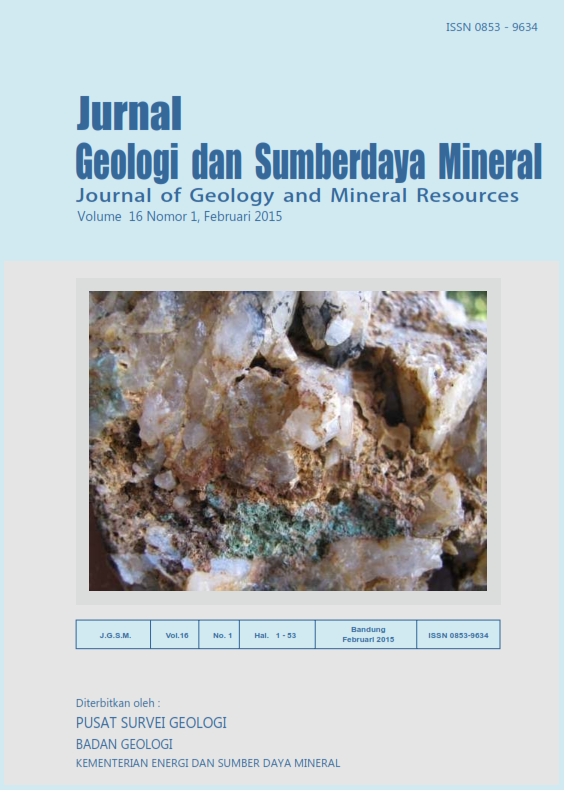PROSPEK CARBON CAPTURE AND STORAGE (CCS) CEKUNGAN LUWUK-BANGGAI DARI SUDUT PANDANG GEOLOGI
DOI:
https://doi.org/10.33332/jgsm.geologi.v16i1.47Abstract
Berdasarkan data kegempaan, daerah Cekungan Luwuk-Banggai kurang prospek terhadap pembangunan konstruksi carbon capture and storage (CCS). Namun keberadaan lapangan-lapangan migas di daerah ini memungkinkan diaplikasikan metode CCS dengan tujuan meningkatkan produksi migas, yaitu dengan sistem EOR (enhanced oil recovery) dengan menggunakan batuan waduk migas sebagai geological storage. Disamping itu, program CCS dengan menginjeksikan CO2 ke dalam akifer dalam berair asin dianggap aman karena CO2 yang bereaksi dengan air asin akan membentuk zat padat bersusunan karbonat sehingga sulit mengalami kebocoran.
Kata kunci : CCS, EOR, akifer air asin, Cekungan Luwuk-Banggai.
Downloads
References
Bachri, S. Dan Baharuddin, 2001. Peta Geologi Lembar Malunda-Majene, Sulawesi, skala 1:100,000. Puslitbang Geologi, Bandung.
Badan Geologi, 2009a. Peta Cekungan Sedimen Indonesia Berdasarkan Data Gayaberat dan Geologi. Badan Geologi, Bandung.
Badan Geologi, 2009b. Peta Percepatan Batuan Dasar Wilayah Indonesia Untuk Perioda Ulang Gempa 500 tahun atau 10% Kemungkinan Terjadi Dalam 50 tahun. Badan Geologi, Bandung.
Charlton, T.R., 1996. Correlation of the Salawati and Tomori basin, estrern Indonesia: a constrain on left-lateral displacement of the sorong fault zone. From Hall, R. & Blundell, D. (eds), 1996. Tectonic Evolution of Southeast Asia, Geological Society Publication No. 106: 465-481.
Darijanto, H., 2005. Analisa Resiko Gempa, Kasus : Proyek Pengeboran Minyak Di Tiaka Field. NEUTRON, v.5, no.1, Februari 2005.
Hamilton W., 1979, Tectonic of The Indonesian Region. Geol. Surv. Prof. Paper, 1078, U.S. Govt. Printing Office: 345 p.
Hasanusi, D., Abimanyu, A., Artono, E. & Baasir, A., G. , 2004. Prominent Senoro Gas Field Discovery in Central Sulawesi: IPA – AAPG Deepwater and Frontier Symposium: 177-197.
Hasanusi, D., Wijaya, R., Shahab, I. & Nurhandoko, B.E.B., 2012. Fracture and Carbonate Reservoir Characterization using Sequential Hybrid Seismic Rock Physics, Statistic and Artificial Neural Network: Case Study of North Tiaka Field. Search and Discovery Article #20139 (2012).
Helmers drr.(1990) Helmers, H., Maaskant, P., Hartel, T.H.D., 1990. Garnet peridotite and associated high-grade rocks from Sulawesi Indonesia. Lithos 25:171-188.
Katili, J.A., 1978. Past and present geotectonic position of Sulawesi, Indonesia. Tectonophysics, 45: 289-322.
Parkinson, C.D., 1991. The petrology, structure and geologic history of metamorphic rocks of central Sulawesi. Unpublished. Ph.D Thesis, University of London.
Silver, E.A, McCaffrey, R. and Smith, R.B, 1983. Collision, Rotation and the initiation of subduction in the evolution of Sulawesi, Indonesia. Journal of Geophysical Research, Vl. 88, No.B11: 9407-9418
Simandjuntak, T.O.,1993. Neogene plate convergence in Eastern Sulawesi. Jour.Geol. Min. Res., 25: 2-9.
Smith, R.B. & Silver, E.A., 1991. Geology of a Miocene collision complex, Buton,eastern Indonesia. Geological Soiety of America Bulletin, v.103: 660-678.
Sukamto, R., 1975. The structure of Sulawesi in the light of plate tectonics. Proceedings of Regional Convention on the Geolology and Mineral Resources of South East Asia. Jakarta.
Zulkarnain, 2010. Sistem Petroleum Cekungan Banggai. kepalabatu.finddiscussion.com. diunduh tgl 15 Juni 2012.
Downloads
Published
Issue
Section
License
Authors who publish articles in Jurnal Geologi dan Sumberdaya Mineral (JGSM.Geologi) agree to the following terms:
- Authors retain copyright of the article and grant the journal right of first publication with the work simultaneously licensed under a CC-BY-NC or The Creative Commons Attribution–ShareAlike License.
- Authors are able to enter into separate, additional contractual arrangements for the non-exclusive distribution of the journal's published version of the work (e.g., post it to an institutional repository or publish it in a book), with an acknowledgment of its initial publication in this journal.
- Authors are permitted and encouraged to post their work online (e.g., in institutional repositories or on their website) prior to and during the submission process, as it can lead to productive exchanges, as well as earlier and greater citation of published work (See The Effect of Open Access)










